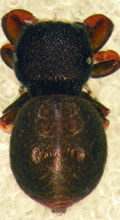Latest News Archive
Please select Category, Year, and then Month to display items
03 April 2018
Photo Google royalty free images
 Nomzamo Winifred Madikizela-Mandela.
Nomzamo Winifred Madikizela-Mandela.
Known to many as the Mother of the Nation, Nomzamo Winifred Madikizela-Mandela has died at the age of 81 on Monday 2 April 2018. She passed away after a period of illness that saw her in and out of hospital.
In honour of this struggle icon, the University of the Free State will fly its flags half-mast as a symbol of respect.
The university conveys its condolences to the family and friends of the late Ms Madikizela-Mandela.
The contributions made by Mama Winnie in the struggle against apartheid will live on, and the world will treasure her fierce spirit forever.
Rest in peace Mbokodo, Mother of the Nation.
UFS entomologists describe a new spider species
2014-02-19
|
 |
It is about 3mm in size and almost looks like a ladybird, but this new spider is the cause of great excitement at the University of the Free State’s (UFS’s) Department of Zoology and Entomology.
The new species of spider, now known as Rhene amanzi, was recently described for the first time and was ‘introduced’ to other arachnologist at the recent congress of the African Arachnology Society at Amanzi Private Reserve.
Dr Charles Haddad, senior lecturer in the UFS’s Department of Zoology and Entomology, said they already stumbled upon the male spider in 2010 when a student was doing research at the reserve. After a very long process, the spider was described and a couple of weeks ago, whilst at the congress, they also found the female.
“Up to now we only know that the spider lives in trees in the Brandfort area. The range could be wider, but since it was only described recently, other arachnologists will only now be able to identify accurately.”
Dr Haddad says they still have to determine how many eggs the female is able to lay, what the spider’s life cycle looks like and what their habitual preferences are.
“What we do know is that it probably isn’t poisonous and that the spider imitates a ladybird in order to protect itself against predators.”